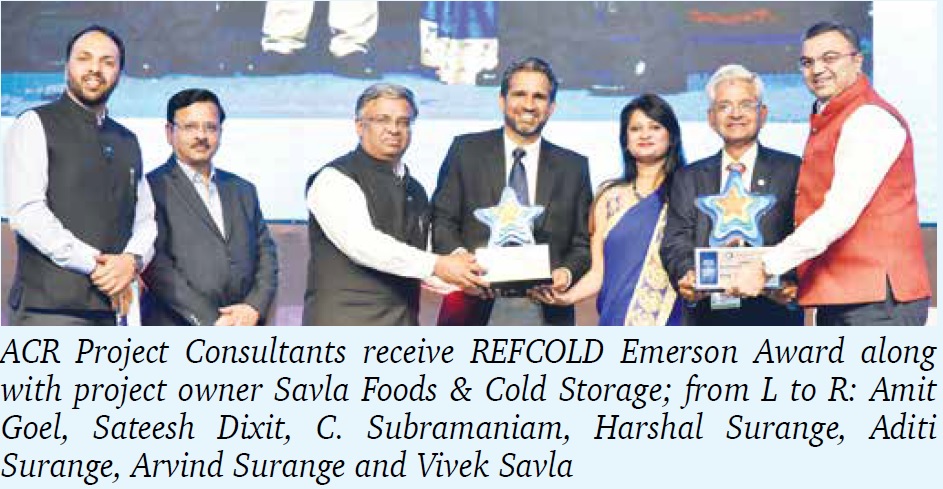REFCOLD India
The much anticipated REFCOLD, a creation of ISHRAE co-organised by NürnbergMesse, turned out to be the biggest show that this industry has seen in India. It began on a grand scale, with the Chief Minister of Gujarat gracing the inaugural event in the presence of a large number of delegates. The show surpassed all expectations in terms of visitor footfall, and marked the spectacular entry of ISHRAE into the Refrigeration and Cold Chain space. As an ISHRAEite, it is a matter of great pride that our Society is working for the spread of knowledge in this space.
It is also a matter of happiness for us to receive the REFCOLD Emerson Award in its very first edition, in the Food Processing category. Such recognitions increase the drive for excellence in any organization, and help the industry in general.
Waste Heat Recovery
There is one energy saving facet in the refrigeration system that is often forgotten, and can prove to be a major energy conservation opportunity. We are talking about waste heat recovery systems. Ordinarily, air conditioning and refrigeration systems are designed to remove heat from interior spaces or products, and reject it to the ambient air. Heat rejection may occur directly to the air, as in the case of most conventional air source units, or to water circulating in a cooling tower. The circulating water eventually rejects the heat to the ambient air in the cooling tower. While this heat is of a ‘low grade variety’, it still represents wasted energy. From an energy conservation standpoint, it would be desirable to reclaim this heat in a usable form. The best and most obvious form of heat recovery is for heating water. Waste heat recovery is a way of generating free hot water from the refrigeration system and it is available, quite literally, free of cost. The only cost is the pumping cost; however, that is a miniscule percentage of the total energy saving possible. It has a double effect. One is the reduction of load on the condenser, because some amount of heat is already removed from the system. The
other is the effective reduction in heating power, either in the form of pre-heated water or direct use hot water.
It is important that before deciding whether heat recovery makes sense for an application, one should know just how much recoverable heat is available. At first glance, the heat available for recovery is the heat that is removed from the room or space. This is only partially true, since there is additional heat available due to the compression of the refrigerant in the compressor. Therefore, the total heat available is the heat removed from the space plus the heat of compression. There are four areas in refrigerant systems where heat can be recovered: condenser, superheat in the discharge gas, compressor jacket or oil coolers, and totally enclosed water-cooled motors.
The discharge gas from the compressor is in a superheated state, and some heat can be recovered from it by desuperheating it before it enters the condenser. The discharge temperatures in most refrigeration systems are quite high (in the range of 70°C to 100°C), and the superheat can be used to heat the water to about 60°C. The amount of heat recovered would be of the order of 10 to 15% of the total heat rejected by the condenser.
Waste heat recovery in industrial air conditioning and refrigeration systems has numerous advantages besides the recovery of heat:
1. The operating condenser duty is reduced when a heat reclaim system is ‘retrofitted’, thus reducing the condensing pressure, which in turn reduces the brake horse power (BHP) of the compression equipment, and/or reduces the condenser fan horsepower. For new installations, it is not recommended to reduce the condenser size
unless the ‘heat reclaim’ requirement coincides with the maximum plant load conditions.
2. Where a desuperheater is installed, the refrigerant gas inlet temperature to the condenser is reduced, thus reducing the ‘fouling’ tendency of the condenser and water treatment requirement.
3. Where a desuperheater is installed, most of the oil that is normally in vapor state will condense, and a good oil separator can remove it. By removing the oil before it gets to the evaporator, system efficiency is increased with the possibility that the suction pressure can be increased.
More information on this is available in ISHRAE Refrigeration Handbook.
Other Events
Other events in the last few months included ICE expo by Global Cold Chain Alliance in Hyderabad, Food Logistics India in Mumbai, and seminars at various levels.
Overall, the last few months have been very happening, and we look forward to the coming weeks.
Disclaimer: The information provided within this publication / eBook/ content is for general informational purposes only. While we try to keep the information up-to-date and correct, there are no representations or warranties, express or implied, about the completeness, accuracy, reliability, suitability or availability with respect to the information, products, services, or related graphics contained in this publication / eBook/ content for any purpose. Any use of this information is at your own risk.
 Youth
Youth
 Women
Women
 Research for Ishrae
Research for Ishrae







